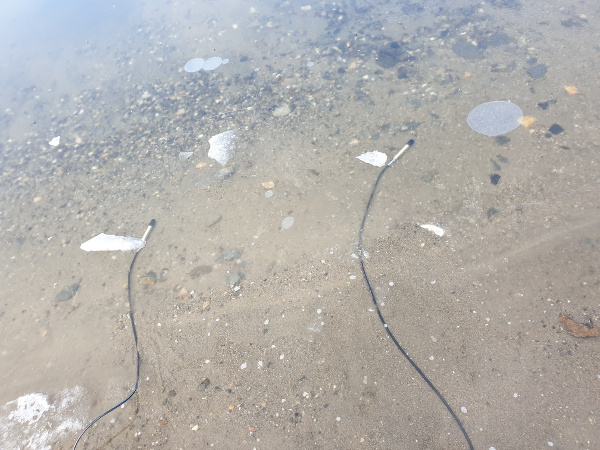Photo credit: Jordan Lacey, 2019
Call for Submissions: "Translating Ambiance: embodiment, practice, listening"
Guest editor: Jordan Lacey
Deadline for abstract proposals: 1st November
This Unlikely issue explores sonic ambiance through the figure and practices of translation. Ambiance is the 'in-between' that emerges between our sensory apparatus and the environments we encounter (Gernot Böhme) and that opens up our perceptibility of the world (Jean-Paul Thibaud). The relationality and affectivity of sound makes it a powerful tool for creating ambiance. Always surrounding us, sound simultaneously has connective and invasive qualities with a capacity to shape our imaginations with its flows and intensities.
Translating sonic ambiances depends on the role of the body in knowing and creating those ambiances in 'natural' and 'urban' spaces. Translation, as Nicolas Bourriard writes, 'always implies adapting the meaning of a proposition, enabling it to pass from one code to another'. The terms nature and urban, heavily coded by cultural and political references, are usually set up in a dualistic opposition. But by transversing nature and the urban -- as a continuum -- a practitioner may be in a position to reveal new possible worlds that exceed and/or are differentiated from the typical environmental codifications of nature vs urban. The possibility for sonic artistic practice to work with ambiance and translate across the nature/urban continuum in this way opens a wider conversation about what our cities -- or spaces -- might become.
The issue documents and builds on an exhibition titled Translating Ambiance, held in Melbourne, Australia 2019. A curated group of sound-artists were invited to consider the role of the body in their field-recording and listening practices, particularly in relationship to the translation of experiences, encounters and spatial expressions/impressions from outdoor environments into gallery settings. As part of the closing stage of the exhibition process, this issue will include their contributions: a mixture of audio essays, video, images and text -- exploring both practice and theory -- that are performative and sensual, rather than didactic. Autoethnography will be one of the key modes of response for this issue by the artists.
In this open call, we are seeking contributions from theorists and/or practitioners grappling with issues centred around embodiment and ambiance/atmosphere, as well as those engaged with autoethnography and artistic practice -- particularly sound art and field work practices. We are also interested in contributions concerned with how artistic practice can contribute to conversations around urban spaces. Can we translate the artistic voice from the experimental sites of the gallery into the societal structures responsible for the formation of our urban environments? What voices might transform the limited codes responsible for our globalised urban ecologies? Can we imagine unactualized environments and ambiances that might lead to the diversification of our everyday lived experiences? How can autoethnographies be foregrounded as a method for illuminating artistic processes, to be adopted more widely in the creation of future cities?
Themes might include, but are not limited to:
- the role of embodiment in field recording and listening practices
- the interface of ambiance/atmosphere and sound-art
- how sound-art works might translate into urban design principles
- relationships between autoethnography, sound-art practices and listening
- relationships between space, imagination and attunement
- manifesting sonic possible worlds through practice and listening
In addition to scholarly articles, we are interested in gathering processual pieces which may be neglected by conventional academia. The issue seeks to provide a platform for artists to express their making process in a format best aligned to their practice. These might include but are not limited to:
- conventional articles and essays
- audio and multimedia essays
- art pieces and their documentations (with commentary/observations)
- documentation of interviews with artists
- processual pieces: from fieldwork to realization
Submission guidelines
- Expression of interest abstract, up to 300 words
- Specify one of the formats in your abstract:
- Scholarly articles: 4000 - 5000 words including works cited
- Other formats of creative writing and non-traditional research:
- 2000-3000 words
- Interviews (2000-3000 words)
- Audio or multimedia pieces (max 10 min + a brief supporting statement, max 1000 words)
- Other forms of visual/audiovisual or interactive art (please, briefly specify in your abstract).
- A short biographical note (max 100 Max)
- Final submissions should be sent as a doc(x) file
Please, submit the abstracts with subject "Translating Ambiance - embodiment, practice, listening" to by November 1, 2019. Authors will be notified by December 1, 2019.
Final versions for peer-review are due by April 15, 2020.
Final reviewed submission by July 30, 2020.
The issue will be released in September 2020.
Please, do not hesitate to contact the guest editor in case any additional questions appear.
Guest editor
Dr Jordan Lacey is a research fellow, curator, sound-artist and writer working across the Schools of Design and Art at RMIT University. He is author of Sonic Rupture: a practice-led approach to urban soundscape design (Bloomsbury 2016), and various articles, which explore the role of sound installations in transforming urban life. Originally a musician and sound-artist, Jordan has become increasingly focussed on the creation of sites-of-encounter in urban environments that might exceed the typical day-to-day functions of city life. He has produced numerous sound art installations (see: hiddensounds.com.au), funded by government and industry partners, that seek to influence approaches to urban design. Jordan has been awarded two prestigious grants, an Australian Research Council (DECRA) grant (2019-21) and Vice-Chancellor’s Postdoctoral Award (2016-19) to continue his research into relationships between everyday life, noise and urban sound art.



